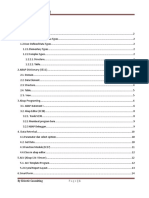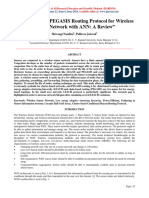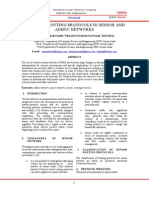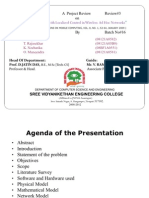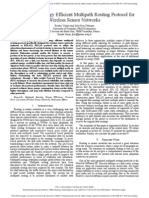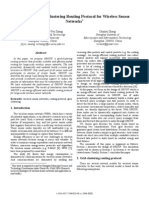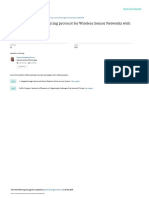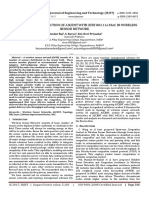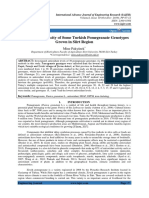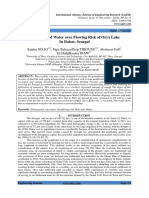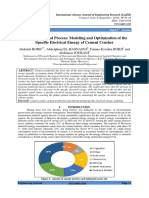Improvements of Pegasis Routing Protocol in WSN: Aya Ayad Hussein, Rajaaaldeenabd Khalid
Improvements of Pegasis Routing Protocol in WSN: Aya Ayad Hussein, Rajaaaldeenabd Khalid
Uploaded by
iajerCopyright:
Available Formats
Improvements of Pegasis Routing Protocol in WSN: Aya Ayad Hussein, Rajaaaldeenabd Khalid
Improvements of Pegasis Routing Protocol in WSN: Aya Ayad Hussein, Rajaaaldeenabd Khalid
Uploaded by
iajerOriginal Title
Copyright
Available Formats
Share this document
Did you find this document useful?
Is this content inappropriate?
Copyright:
Available Formats
Improvements of Pegasis Routing Protocol in WSN: Aya Ayad Hussein, Rajaaaldeenabd Khalid
Improvements of Pegasis Routing Protocol in WSN: Aya Ayad Hussein, Rajaaaldeenabd Khalid
Uploaded by
iajerCopyright:
Available Formats
International Advance Journal of Engineering Research (IAJER)
Volume2, Issue 11 (November- 2019), PP 01-14
ISSN: 2360-819X
www.iajer.com
Research Paper Open Access
Improvements of PEGASIS Routing Protocol in WSN
Aya Ayad Hussein1*, RajaaaldeenAbd Khalid2
1,2
(College of Information Engineering, Al-Nahrain University, Baghdad, Iraq)
*Corresponding author: Aya Ayad Hussein1
ABSTRACT : The Wireless Sensor Networks (WSNs) is one of the succeeded technology that being strongly
considered in scientific and engineering fields. WSN is an ad-hoc network that consists of small nodes with
sensing, computing and communicating wireless abilities. These Sensor nodes are usually have limited lifetime
duration due to the sensors that powered by limited exhaustible batteries. The main aim of WSN is to sense all
the information from the environment (The environment can be an Information Technological framework, a
physical world, or a biological system) based on the kind of application for which is deployed and send this
information to it is Base Station (BS). Sensor nodes have to ensure their task with their rigorousenergy budget,
this constraint makes theenergy resource the most of critical importance in the WSNs. Sensor Nodes
communicate with each other by different Routing Protocols, and Routing Protocols can be classified into
different categories in WSNs. This paper will focus on the Hierarchical (cluster based) routing protocols. Also,
we will go deeply in PEGASIS protocol backgrounds and improvements,complete description for each stage of
improvements, models, and offering a complete vision for these protocols through making a comparison
between them by knowing there positive and negative effects on WSN.
Keywords -Wireless Sensor Network, Cluster-based routing protocols, LEACH, PEGASIS, EEPB, PEGASIS-
ANT, H-PEGASIS, PDCH, IEEPB, MIEEPB, ACO.
I. INTRODUCTION
Due to the advances in the WSN technology field, it become necessary to explore new ways or new
techniques such as improving routing protocols by using many intelligent systems and optimization algorithms
to keep abreast of developmentsthat affects in WSN technologies positively. These routing protocols applied on
small and cheap sensor nodes to achieve an efficient communication between these sensors nodes in the whole
network. The architecture of sensor nodes is showing in the Fig. 1.These sensor nodes are very sensitive in
terms of energy that will leads to limited energy supply and in turn will cause a short network lifetime, to
recover this issue we have to use efficient routing protocols that will ensure efficient and reliable
communication between these nodes. In this paper, author present a simple comparative study about specific
protocol, PEGASIS protocol and it is improvements that proposed at recent years [1-2-3-4-5]. The rest of the
paper organized as follow. Section 2, describe simply routing protocol and it is classification with focusing on
the second type of routing protocol, hierarchal (cluster based) routing protocols. Section 3, describe PEGASIS
routing protocol with it is genesis and improvements and show their models. Section 4, comparison and
summarize these cluster-based routing protocols, and section 5concludes the paper
Engineering Journal www.iajer.com Page | 1
Improvements of PEGASIS Routing Protocol in WSN
Fig. 1 Sensor node
architecture
II. ROUTING PROTOCOLS IN WSN
Routing is a mechanism that initiate a route between a source node and destination node. The main
goal of routing protocols is to discover the best route (shortest path) in terms of energy consumption, delay,
quality of service and other metrics to make sure to extend the network lifetime by keeping the sensors node
alive as can as possible [2]. Therefore WSN routing protocols can be sorted and classified based on different
metrics, based on network structure the routing protocols classified into three main categories:
Flat routing protocols.
Hierarchal (cluster based) routing protocols.
Location based protocols.
Fig. 2 WSN routing protocols
In this paper we will focus on the routing protocols that classified based on the network structure
especially those called hierarchal routing protocols. In flat routing protocol, all the nodes is working together
based on the same role in the same manner and because of the limited resources this type is not preferred or not
used a lot at large scale networks. In hierarchal routing protocols all the nodes working together but in different
scenario by distributed these nodes into groups called cluster heads and each grope execute its own tasks , this
will provide many useful and supported features to the network such as scalability, energy efficiency , and
increased network lifetime. Finally, the locationbased routing protocol is that path creation between each node
will depend on each node position [2-4-6-7].
2.1. Hierarchal routing protocols
Hierarchal routing protocols also called cluster based routing protocols. It is concept is stand for
dividing the network into many regions of interconnected nodes these regions called cluster, each cluster
contains a node called cluster head which has specific feature that it owned highest energy among all the nodes
Engineering Journal www.iajer.com Page | 2
Improvements of PEGASIS Routing Protocol in WSN
in the same region. These clusters also divided in to a layered structure, it is usually contains two layers. The
processing idea of sending data or information between nodes in this hierarchal or layering structure based on
sending information from the lowest energy nodes to the highest energy nodes. This mean that the nodes those
have lowest energy is responsible for sensing and sending information to cluster head while the nodes those
have highest energy is using for processing information and send to another cluster head or to base station by
using a gateway nodes.This type of routing have many benefits and damages on any ad-hoc network, it is
basically minimizes on demand route discovery traffic and routing overhead, reduce route determination delay
and increase packet delivery ratio. On other hand, it is negative effect on the network rises when the clusters
increases in size because it will increase packets overhead due to it is routing source. Also, increasing packet
size because of the operation that happened when every node of the route must be stored in the routed packet so
the more route increase the more packet size will increase. That leads us to a bigger problem is the increasing of
transmission time because of the two previous negative point. [2-3-6-7-8]
III. STAGES OF BUILDING PEGASIS PROTOCOL AND IMPROVEMENTS
In this section, you will find a complete idea about the hierarchal routing protocols. Especially, that are
belongs to the chain cluster based routing protocols. However, each protocol has its own special mechanism of
communication and data transmission between their interconnected nodes but the most of these protocols are
depending on the first order radio model to make the process of transferring data completed perfectly.
Therefore, to transmit number of bits message with a certain distance using this radio model, the radio
expends[6]:
𝐸𝑡𝑥 𝑘, 𝑑 = 𝐸𝑡𝑥 − 𝑒𝑙𝑒𝑐 𝑘 + 𝐸𝑡𝑥 − 𝑎𝑚𝑝 𝑘, 𝑑 (1)
𝐸𝑟𝑥 𝑘 = 𝐸𝑟𝑥 − 𝑒𝑙𝑒𝑐 𝑘 (2)
𝐸𝐷𝐴 𝑘 = 𝐸𝐷𝐴 − 𝑒𝑙𝑒𝑐 𝑘 (3)
Where:
𝐸𝑒𝑙𝑒𝑐 :The energy that consumed by the radio to run the transmitter or receiver circuitry, (equal
to50 nJ/bit).
𝐸𝑎𝑚𝑝 :The required energy for transmitter amplifier, (equal to 100 𝑝𝐽/𝑏ⅈ𝑡/𝑚2 ).
𝑘 : Number of bits.
𝑑 : Distance.
𝐸𝐷𝐴 : The energy that consumed by Transmitter circuitry to aggregate the data received by the child
nodes, (equal to 50 𝑛𝐽/𝑏𝑖𝑡).
Fig.3 first order radio model (free space)
Or can be expressed such as:
𝐸𝑡𝑥 𝑘, 𝑑 = 𝑘 × 𝐸𝑒𝑙𝑒𝑐 + 𝑘 × 𝐸𝑎𝑚𝑝 × ⅆ2 𝑤ℎ𝑒𝑛 ( 𝑑 < 𝑑0 ) (4)
Or
𝐸𝑡𝑥 𝑘, 𝑑 = 𝑘 × 𝐸𝑒𝑙𝑒𝑐 + 𝑘 × 𝐸𝑚𝑝 × ⅆ4 𝑤ℎ𝑒𝑛 ( 𝑑 ≥ 𝑑0 ) (5)
𝐸𝑟𝑥 𝑘 = 𝑘 × 𝐸𝑒𝑙𝑒𝑐 (6)
Where:
ⅆ2 : Represent power loss in free space with d 2 and with d 4 power loss.
ⅆ4 : Represent power loss in multipath fading
Engineering Journal www.iajer.com Page | 3
Improvements of PEGASIS Routing Protocol in WSN
𝑑0 : Represent threshold
Also, as mention previously:
𝐸𝑒𝑙𝑒𝑐 : The energy that consumed by the radio to run the transmitter or receiver circuitry, (equal
to50 𝑛𝐽/𝑏𝑖𝑡).
𝐸𝑎𝑚𝑝 : The required energy for transmitter amplifier in free space, (equal to 100 pJ/bⅈt/m2 ).
𝐸𝐷𝐴 : The energy that consumed by Transmitter circuitry toaggregate the data received by the child
nodes, (equal to 50 𝑛𝐽/𝑏𝑖𝑡).
𝐸𝑚𝑝 : The required energy for transmitter amplifier in multipath model
Fig.4 PEGASIS improvement stages
3.1 LEACH protocol (Low-Energy Adaptive Clustering Hierarchy)
It is one of the most popular routing protocol. This protocol is block cluster based routing protocol, leach
protocol architecture based on a distributed clustering algorithm, all sensors nodes communicating together
using the first order radio model continues in negotiation between each other throughout the work period about
who will take the place to be the chosen cluster head. The cluster head selection process will be divided into
rounds, in each round the process will be done with 1/p probability for each sensor node to become the next
cluster. The decision of selecting a node to be the next cluster head is depend on the node number chooses
between 0 and 1. If the number is less than a threshold T (n), the node becomes a cluster-head for the current
round otherwise it will be consider as a regular node. The threshold represented below:
𝑃
1 𝑖𝑓 𝑛 ∈ 𝐺
𝑇 𝑛 = 1−𝑃∗ 𝑟 mod
𝑃 (7)
0 𝑜𝑡ℎ𝑒𝑟𝑤𝑖𝑠𝑒
Where:
𝑃: The desired percentage of cluster heads.
𝑟 : the current round
𝐺 : is the set of nodes that have not been cluster-heads in the last rounds.
as a result, each node will be a cluster head for a once this in turn will save energy consuming and increase the
network lifetime because of the changeable cluster head node process that will consumed the node energy [9-
10-11]. Leach protocol is a self-organized protocol that choose the cluster head randomly or based on some
metrics such as the energy. The cluster head will be responsible for collecting information from the nodes,
aggregate this information and forward it to the base station [2-5-12-13].
Engineering Journal www.iajer.com Page | 4
Improvements of PEGASIS Routing Protocol in WSN
Fig. 5 LEACH protocol
3.2 PEGASIS protocol (Power-Efficient Gathering in Sensor Information Systems)
A proposed protocol by [14] that present an improvement over leach protocol. This protocol is a chain cluster
based routing protocol that present a different mechanism of actions than the Leach protocol. The nodes that
under the law of PEGASIS protocol is also communicating with each other depending on the first order radio
model, equations (1)(2)(3) that been mentioned previously in this paper.There is some steps that should be
follow when using PEGASIS protocol and can be classify into two phase:
Chain formation
The process of building a chain based on greedy algorithm between sensor nodes to guaranty the
communication between each sensor node with it is nearest neighbor, then send the data that been collected and
gathered in the end of the chain to the leader node or to the node that is the closet to the base station. The
construct of the chain always begins from the furthest node [8-10-11-15].
Fig.6 PEGASIS protocol chain
Data collecting and gathering
In second phase, each node will take the data of it is neighbor and emerge it with it is data then forward the
gathered data to next node as a cumulative process. The leader will be responsible for sending this data to the
base station. In addition, in each round there is different leader node in different location is chosen randomly
and used [8-10-11-14].
Fig.7Control token passing approach in PEGASIS
Engineering Journal www.iajer.com Page | 5
Improvements of PEGASIS Routing Protocol in WSN
In a certain round, the leader will build control token passing approach to get the gathered data from
the further node to the nearest one and forward it to the base station. In the fig.7 the leader node is n2 so the first
token will be pass from n0 through n1 and reach the leader node n2 then the second token will be pass from n4
through n3 and also reach the leader node n2. All the data from the two direction will be gather in n2 then
forward to the base station. [8-10-11-14-16]
3.3 EEPB (Energy Efficient PEGASIS based algorithm)
It is an improved protocol over PEGASIS protocol. The aim of EEPB is to overcome the shortcomings
in the PEGASIS protocol by solving the problem of long links of chains because of the long distance between
nodes that is occur on account of greedy algorithm which been used in PEGASIS protocoland in turn will cause
high energy consumption and fast node death [17].EEPB protocol handle this problem by initiate a distance
threshold that will applied on the average distance of formatted chain to decrease the problem of long link
initialization as shown in next equations :
h
Dp
Daverage = h
(8)
p=1
Where:
Daverage : is the average distance in the formed chain.
h: is the hop number of the formed chain.
Dp : is the distance of every segment in the formed chain, where (p=1, 2, 3 …h).
If the distance between an end node in a formed chain and a new requested node to join with that
formed chain of nodes is longer than Dthreshold then the possibility of creating LL problem will be
high.
Dthreshold = α ∗ Daverage (9)
Where:
Dthreshold : is the threshold distance.
α: is a user defined constant.
In addition, the leader node selected by EEPB according to two factors: the residual energy of node with the
distance between nodes and base station. Once the chain is created, the data transmission Stage begin by
collecting and gathering the data from each node in accumulative way until it reach the leader node that will be
responsible for sending these data to the base station. As a result the power will be saved and balanced between
nodes [16-17-18].
3.4 PEGASIS-Ant
PEGASIS improvement in this protocol is present by using ant colony optimization algorithm (ACO) instead of
greedy algorithm in order to form the chain. This in turn will lead to a global optimization. ACO is an intelligent
algorithm that based on the real ant behaviour. Ants depend on the chemicals were spread byants that precede
them which pass through a specific route, these chemicals called pheromones [19]. Ants will choose to follow
trails that have pheromone in it is higher levels than trails with lower pheromones levels. Therefore, as more
ants use a certain path, the pheromones trail raised stronger and will have higher probability to be chosen by
ants. Leader node selection will depend on the distance between node and BS. Therefore, the nearest node from
the base station is the leader node [20-21-22]. The ACO algorithm construct the chain of nodes to get the best
path based on ant communicationwhich Accredited on selection the lesser number of nodes, this help tomaintain
more energy and balance energy consumption between nodes [16-23-24-25-26-27].
The general idea of ant colony algorithm is shown in the figure.8 in four steps:
First step: exploring
To discover the surrounding area by sending different individual ants from the nest into different direction
to search for a food.
Second step: Pheromone trail:
When the individual ant go into a certain direction, a pheromone trail will be created in the yellow colour
as it shown fig.8.
Third step: additional node:
A new node is add into the trail because of the exploratory nature of ants.
Fourth step: shortest path: after several times of trying to search and discover new path , the shortest
path is found and ants swarm is head for the same direction that have the highest pheromones level and
this will ensure to the other ants that this path is the shortest path to reach to food .
Engineering Journal www.iajer.com Page | 6
Improvements of PEGASIS Routing Protocol in WSN
Fig. 8 Ant colony optimization algorithm
The next equations is represent mathematically the previous process [19-20]:
𝛼 𝛽
𝜏 𝑖𝑗 (𝑡) . 𝜂 𝑖𝑗
𝑃𝑘ⅈ,𝑗 𝑡 = 𝛼 𝛽
(10)
𝜏 𝑖𝑗 (𝑡) . 𝜂 𝑖𝑗
𝑘∈𝐽 𝑘
Where:
𝑃 ⅈ,𝑗 : The traveling from node i to node j probability.
𝐽𝑘 : The nodes that the antPass through it in advance and travel to from node i.
𝜂𝑖𝑗 : The visibility between node i and node j.
𝜏𝑖𝑗 (𝑡) : The quantity of un-evaporated pheromone between node i and node j at time t.
α and β : control the effect of τij(t) and ηi j .
Where if α <β then the searching behavior of ant is more depending on pheromone.
And if β < α then the searching behavior of ant is depending on its visibility or knowledge.
However, each ant has a list of nodes location than been visited by ant previously to ban the ants from going to
another time. The following equation is used to express the depositing pheromone process [19-20]:
𝑄
𝑡
∆𝜏𝑖𝑗𝑘 𝑡 = 𝐿𝑘 (11)
0
Where:
Q: is a constant.
L:. The length of the generated path.
t: is the iteration number.
K: represents the ants number.
∆𝜏𝑖𝑗𝑘 𝑡 : Represents the pheromone rate between node i and node j that the ant visited in iteration t.
The pheromone deposition value is zero for a path that is not selected previously.
Thefollowing equation is using to utilize the pheromone evaporation rate:
𝑚
𝜏𝑖𝑗 𝑡 + 1 = 1 − 𝑝 . 𝜏(𝑖,𝑗 )(𝑡) + 𝑘=1 [∆ 𝜏 𝑘ⅈ,𝑗 (𝑡)](12)
Where:
m: represents the number of ants in the system.
p : represents the pheromone evaporation rate or decay factor.
Engineering Journal www.iajer.com Page | 7
Improvements of PEGASIS Routing Protocol in WSN
Fig.9AntColony Algorithm Flowchart
3.5 H- PEGASIS (hierarchal PEGASIS)
It is a beneficial extension, which add to the PEGASIS protocol. This extension based on parallel processing
between nodes. In other word, this technique allow to transfer data simultaneously from different nodes to other
different ones in a parallel way by send the data from the lower layer to the upper layer up to the base station as
hierarchal structure. In addition, a signal coding technique will be use such as CDMA to avert any collisions of
data that will result an interference. This solve the problem of delay by depending on multiple chains in the
same time instead of single chain and using a signal coding technique. Therefore, the problem of energy
consumption also will be solve smoothly [16]. This extension will be obvious in MIEEPB protocol that will be
describe later in this paper.
3.6 PDCH (PEGASIS Double Cluster Head)
The technique of increasing the cluster head by doubled it will affect the whole network positively by
decreasing the traffic and in turn avoiding high delays. Normally PEGASIS protocol uses one CH that
communicates with the BS. Nowadays, using double cluster head is being preferred more than using single
cluster head. The technique of add more cluster head is based on the mechanism of communicating between
cluster heads of each layer in a hierarchal form [16-18-28-29]. After chains formation stage is completed, the
stage of cluster head selection is begin by choosing the nodes as a primary cluster head or secondary cluster
head or either a regular node based on it is weights, the weights Q of nodes can be found or calculated by
dividing it is residual energy with it is distance from the BS. The network decide to choose the node that have
the highest weight as a primary cluster head. After choosing the primary CH, each node in the chain computes it
is distance with the parent nodethat was assumed as p1, and compare it with the distance to sink node p2. If the
distanceof p2 > p1then the node will be consider as a secondary CH otherwise it will be consider as a regular
node participating in the chain.
𝐸
𝑄𝑖 = 𝐷𝑖 (13)
𝑖
Where:
Ei indicate the residual energy of sensor node i
Di Indicate the distance between sensor node iand sink.
This will provide many availssuch as decreasing the delay in transmission and receiving process between nodes
by giving the responsibility of collecting data from the nodes in a certain layer by their cluster head so a cluster
head will present in a form of main cluster head and secondary cluster head as shown in fig.10 As a result, this
provide balancing the load of each node and increase network lifetime [18-21-28-29-30-31].
Engineering Journal www.iajer.com Page | 8
Improvements of PEGASIS Routing Protocol in WSN
Fig.10 Double cluster head chain
3.7 IEEPB (Improved Energy Efficient PEGASIS based algorithm)
EEPB overcomes several problems over PEGASIS but still has some deficiencies such as the long link
(LL) phenomena and weakness in the mechanism of selecting the leader node, which will be mentioned with
more details in the next few pages. IEEPB is an improved protocol over EEPB protocol. This protocol deal with
the issues that faced us with EEPB through reducing the construction of long link (LL) in chain by using
threshold [17-18]. ]. In IEEPB, threshold process is to calculate and compares the distance between nodes
double time, finds the shortest path to link the two adjacent nodes. Also, by selecting the appropriate leader
node based on the weighting algorithm. Weighting algorithm works by taking into account each node energy
with the distance between each node and base station then distribute the weight coefficients on the leader node
as shown in the following equations:
𝐷𝑏𝑠 = 𝑑𝑇𝑜 𝐵𝑆 ∕ ⅆ𝑎𝑣𝑒 (14)
Where:
𝑑 𝑇𝑜 𝐵𝑆 : Distance between sensor node and BS.
ⅆ𝑎𝑣𝑒 : Average distance between sensor nodes and BS.
𝐸𝑝 = 𝐸𝑖𝑛𝑖𝑡 /𝐸𝑖 (15)
Where:
𝐸𝑝 : Portion energy.
𝐸𝑖𝑛𝑖𝑡 : Initial energy of node i.
𝐸𝑖 : residual energy of node ifor round n
𝑊𝑖 = 𝑤1 𝐸𝑝 + 𝑤2 𝐷𝑏𝑠 (16)
𝑤1 + 𝑤2 = 1 (17)
Where:
Wi : combined weight of each node.
w1 , w2 : Coefficient of weight factors.
If w1 > w2 then means that the most effecting factor to select the leader node is the residual energy.
If w1 < w2 then means that the most effecting factor to select the leader node is the distance between the
node and BS.
Finally, the node that have the smallest weight will be chosen to be the leader node [16-17-18].
3.8 MIEEPB (Mobile sink improved energy-efficient PEGASIS-based routing protocol)
After EEPB problems been solved by the next emerged version IEEPB, IEEPB removes various deficiencies in
EEPB; however, it still has some shortcomings such as major load on the single chain leader, large delay in data
delivery, sparse nodes in the network that facing instability periods. MIEEPB is an improvement over IEEPB
that present the sink mobility in a multi-chain model, therefore construct and applying smaller chains decreasing
load on the leader nodes [32]. MIEEPB mechanism is the same of previous protocol IEEPB by using the first
order radio model to ensure an efficient communication between sensor nodes. Also by using token passing
Engineering Journal www.iajer.com Page | 9
Improvements of PEGASIS Routing Protocol in WSN
approach to transmit the data between nodes. In the [32] used MIEEPB and insert both extensions of multi-chain
and double cluster head as shown in fig11. DCH also selected by using the weighting algorithm to specify the
primary and secondary cluster head. Finally, in MIEEPB a mobile sink is been used by specify the sojourn time
and sojourn location. Mobile sink node divide WSN area into more than one region as in the [32 divided into 4
regions and consider that in each round the sink node will complete one course around the 4 sojourn locations as
follows
4
𝑇𝑠 = 𝑖=1 𝜏𝑖 (18)
Subject to :
𝐷𝑖𝑓𝑖 = 𝑗
𝑥𝑖𝑗 = (19)
0 𝑜𝑡ℎ𝑒𝑟𝑤𝑖𝑠𝑒
Where:
Ts : Total sojourn time of one course.
𝑥𝑖𝑗 : The number of bits transmitted between chain leaders and the sink.
𝑖 , 𝑗 : sink potential locations were i=1, j=4.
𝐷 : Total data transferred between chain leaders and the sink in sojourn time.
Fig.11 MIEEPB multi-chains and multi cluster head in WSN
In other words, MIEEPB is a multi-chain model with continuesfixed path mobility of sink node and limited
potential locations, this achieve proficient energy utilization of wireless sensors and to ensure maximizing of
network lifetime [27-32]
IV. COMPARISON
Table-1 summarizes the comparison between LEACH, PEGASIS, and the popular improvements protocols of
PEGASIS protocol on the basis of it is advantages and disadvantages on the WSN.
Table-1 Advantages and disadvantages of hierarchal routing protocols
Algorithms Advantages Disadvantages
LEACH Leach uses TDMA, this prevent CHs from Useless on a large regions network
[2-5-9-10-11-12-13] any collisions. deployments.
Balancing energy dissipation of each node, Extra overhead on CH nodes due to
by giving each node an equal probability to the dynamic clustering process.
become a cluster head. Wasting lots of energy because of the
Outmatches conventional routing fixed initial amount of energy
protocols. capacity for all nodes in each round.
Completely distributes so no need for
control.
Engineering Journal www.iajer.com Page | 10
Improvements of PEGASIS Routing Protocol in WSN
PEGASIS Better than leach in energy distribution High delays caused by long
[8-10-11-14-15-16- throughout the network. communication distance between
33] Saving energy duo to the shorter distance each node.as a result, this will
between nodes. So, the process of consume more energy.
transmitting and gathering data will have Low scalability.
consumed less energy than it consumed Useless for time varying topology.
with leach protocol.
Saving energy better than leach due to the
amount of messages that received by leader
node. in Pegasis, leader node only receives
two messages while in leach received 20
messages assuming 20 nodes per cluster in
a network with 100 nodes.
Minimize the number of messages, last
node in a chain is sending the Final
message as only one message to the BS,
whilst in leach is more than one message
from different nodes at the same time is
received by BS.
EEPB Keep the network far from the phenomena Uncertainty of the distance threshold
[16-17-18] of long link that raised previously in that will have caused once again the
PEGASIS protocol by using a distance problem of long links.
threshold. Unappropriated leader selection, dose
not taking into account the residual
energy of nodes and the distance
between them when selecting the
leader node.
PEGASIS-ANT Ant colony is smoothly acclimatized to Encourage doldrums periods and
[16-20-21-22-23-24- the PEGASIS chains construction either hotspot problem among sensor nodes
25-26-27] as static, dynamic or mobile that will cause rapid drain with the
environments. energy rate of a certain sensor nodes.
form an optimal routing path from node This will also lead to dead node that
to other node that ultimately: can minimize the network lifetime
To alleviate the problemof long link Adequate memory is needed to store
in PEGASIS protocol. all information between hops.
Improves energy efficiency.
Improves energy consumption.
Decrease delay.
H-PEGASIS Minimize the delay of transmission Only spatially separated nodes are
[16] packets to the BS allowed transmit data at the same
Avoid collisions. time as a parallel processing.
Avoid signal interference.
PDCH outperforms PEGASIS and EEPB by: Time delay and unbalanced load
[16-18-21-28-29-30- extinguish the overhead of dynamic distribution is occurring when the
31] cluster formation location of the double cluster head is:
reducing distance of non-cluster First cluster head location is far
heads that must transmit away from the second cluster
Restricting the number of head and in different directions.
transmissions and receives among When the double cluster head
all nodes, and using only one location is far away from the base
transmission to the BS per round. station.
Distributing the energy load among the
nodes that will lead to increase the
lifetime and quality of the network.
IEEPB Avoids problem of consistence long High loads on the single chains due
[16-17-18] links. to the distance between sink node
Efficient leader node selection by and the chain.
considers two factors residual energy and Large delays.
Engineering Journal www.iajer.com Page | 11
Improvements of PEGASIS Routing Protocol in WSN
the distance between nodes to execute the Long distance between nodes effect
process of giving a weight coefficient for negatively on the rest nodes.
each node.
MIEEPB Appropriate for delay intolerant Sink mobility not appropriate for
[27-32] applications. randomly nodes with motion in the
Multi-chain concept decreases the network to communicate with, this
network overhead. will increase delay, congestion, and
Using multi-chain concept reduce the overhead.
distance between nodes
Sink mobility use the technique of
secondary chains head. As a result, this
will mitigate the loads on the nodes that
is nearest from the sink node
Multi- chain concept decreases the delay
of delivering data.
Multi- chain concept decrease the load on
the leader node in a single chain as in
IEEPB
V. CONCLUSIONAND FUTUER WORK
In this paper, we describe the importance of WSN technology to use in several fieldsthat serve the
human needs with this Accelerated World. Routing protocols of WSN Plays a pivotal role in improvements of
networksin general, as reviewed in this paper before. A hierarchal routing protocols get all the attention in this
work especially those who are specified in chain cluster based routing protocols. It is described based on the
protocols that represent the history of PEGASIS protocol and the improvements that raised after, describe there
mechanism and models. Then, these protocol is summarized in a detailed comparison table that represent
advantages and disadvantages. Therefore this table will lead us to conclude the effect of the improvements that
been established on the PEGASIS protocol to become more efficient and this in turn will minimize the energy
consumption by overcome the LLs problem and enhance the performance of the protocol to maximize the
network lifetime.
REFERENCES
[1]. Alhasanat, A. A. Alhasanat, K. M. Alatoun& A. AlQaisi “Data Gathering in Wireless Sensor Networks
Using Intermediate Nodes“, International Journal of Computer Networks & Communications.
7(1),2015, 113-124.
[2]. Santar PalSingh&S.C.Sharma, “A Survey On Cluster Based Routing Protocols In WirelessSensor
Networks” , Elsevier, Procedia Computer Science, International Conference on Advanced Computing
Technologies and Applications (ICACTA). 45, 2015, 687-695.
[3]. Jamal N. Al-Karaki & Ahmed E. Kamal,“Routing Techniques in Wireless Sensor Networks: A
Survey”, IEEE, Security and Networks,11(6), 2004,6-28.
[4]. Sudip Misra & Sumit Goswami, “Network Routing: Fundamentals, Applications, and Emerging
Technologies”, John Wiley & Sons Ltd. 1st edition, Chapter 11, 2017, 285-325.
[5]. Geetha. V., Pranesh.V. Kallapur, SushmaTellajeera, “Clustering in Wireless Sensor Networks:
Performance Comparison of LEACH & LEACH-C Protocols Using NS2”, Elsevier, Procedia
Technology, 4 , 2012,163-170.
[6]. Naveen Kumar, Jasbir Kaur “Improved LEACH Protocol for Wireless Sensor Networks”, IEEE
Proceedings of the 7th International conference on wireless communications, networking and mobile
computing,DOI: 978-1-4244-6252-0/11,2011.
[7]. R. Ennaji & M. Boulmalf “Routing in Wireless Sensor Networks”, IEEE, Proceedings of the
International Conference on Multimedia Computing and Systems,DOI: 978-1-4244-3757-3 /09,2009,1-
6.
[8]. R. Ghosh “Comparative Performance Analysis of Routing Protocols in Wireless Sensor Network”,
International Journal of Sensor Networks and Data Communications, 5(4),2016, 1-5.
[9]. W. R. Heinzelman, A. Chandrakasan, & H. Balakrishnan, “Energy-Efficient Communication Protocol
forWireless Microsensor Networks”, IEEE, proceedings of the 33rd hawaii international conference on
system sciences,DOI:0-7695-0493-0/00, 2000,1-10.
Engineering Journal www.iajer.com Page | 12
Improvements of PEGASIS Routing Protocol in WSN
[10]. Laiali Almazaydeh, Eman Abdelfattah, Manal Al- Bzoor, and Amer Al- Rahayfeh , “Performance
Evaluation of Routing Protocols in Wireless Sensor Networks”, International Journal of Computer
Science and Information Technology, 2(2),2010, 64-73.
[11]. P. Bansal, P. Kundu&Prabhjot Kaur , “Comparison of LEACH and PEGASIS Hierarchical Routing
Protocols in Wireless Sensor Networks”, International Journal of Recent Trends in Engineering &
Technology, 11, 2014,139-144.
[12]. Shio Kumar Singh , M P Singh , and D K Singh , “Routing Protocols in Wireless Sensor Networks –A
Survey” , International Journal of Computer Science & Engineering Survey (IJCSES) , 1(2),2010,63-
83.
[13]. S. Jiang ,“LEACH Protocol Analysis and Optimization of Wireless Sensor Networks Based on PSO
and AC”, IEEE, proceedings of 10th International Conference on Intelligent Human-Machine Systems
and Cybernetics,DOI:978-1-5386-5836-9/18, 2018, 246-250 .
[14]. S. Lindsey ; C.S. Raghavendra, “PEGASIS: Power-Efficient Gathering in Sensor Information
Systems”, IEEE, Proceedings of IEEE Aerospace Conference, 0-7803-7231-X, 2002, 1-7.
[15]. Tao Li, F. Ruan, Z. Fan, Jin Wang & Jeong-Uk Kim ,“ An Improved PEGASIS Routing Protocol
Based on Neural Network and Ant Colony Algorithm”, International Journal Of Future Generation
Communication And Networking, 8(6),2015,149-160.
[16]. P. Kalkandha, C. Wahi, S. Sharma & S. K. Sonbhadra , “ Current State of Art of Energy Efficient
PEGASIS Routing Protocols in WSNs”, International Journal of Advanced Research in Computer
Science and Software Engineering, 5(12),2015,455,460.
[17]. Feng Sen, Qi Bing &Tang Liangrui, “An Improved Energy-Efficient PEGASIS-Based Protocol in
Wireless Sensor Networks”, IEEE, proceedings of the eighth international conference on fuzzy systems
and knowledge discovery,DOI: 978-1-61284-181-6, 2011,2230-2233.
[18]. S. Vhatkar , J. Rana & M. Atique, “Performance Evaluation and QoS Analysis of EEPB and PDCH
Routing Protocols in Wireless Sensor Networks”, IOSR Journal of Computer Engineering, 17(5), 2015,
101-109.
[19]. Dorigo M, Birattari M, Stutzle T.,“Ant Colony Optimization”, Computational Intelligence Magazine,
IEEE, 28–39, 2006.
[20]. Dorigo M. “Optimization, learning and natural algorithms”. Ph.D. Thesis, Politecnico di Milano,
Milan.1992.Available: http://ci.nii.ac.jp/naid/10016599043/.
[21]. J. Yang, M. Xu, Wei Zhao & B. Xu , “A Multipath Routing Protocol Based on Clustering and Ant
Colony Optimization for Wireless Sensor Networks”, Sensors, 10, 2010,4521-4540.
[22]. S. Okdem & D. Karaboga, ” Routing in Wireless Sensor Networks Using Ant Colony Optimization”, ”,
IEEE, proceedings of the First NASA/ESA Conference on Adaptive Hardware and Systems,DOI:0-
7695-2614-4/06, 2006, 1-4.
[23]. B. Chandra Mohan & R. Baskaran , “A survey: Ant Colony Optimization based recent research and
implementation on several engineering domain”, Elsevier, Expert Systems with
Applications,39,2012,4618-4627.
[24]. B. Yang, Q. Ma & J. Wang , “Study on the Routing Technology of Wireless Sensor Network Based on
Ant Colony Optimization”, Journal of Sensor Technology, 6, 2016,141-158.
[25]. X. Fan, H. Jia, Lin Wang & Pengfei Xu , “Energy Balance Based Uneven Cluster Routing Protocol
Using Ant Colony Taboo for Wireless Sensor Networks”, Springer, Wireless Personal
Communications, 97(1), 2017,1305–1321.
[26]. J. Wang, J. Cao, R. S. Sherratt & J. H. Park , “An improved ant colony optimization-based approach
with mobile sink for wireless sensor networks”, Springer, The Journal of Supercomputing, 74(12),
2017pp 6633–6645.
[27]. A. A.Hussein and R. Abd Khalid, “A Comparative Study of Swarm Intelligence-Based Optimization
Algorithms in WSN”, Asian Journal of Engineering and Applied Technology,8(3),2019,1-7.
[28]. Wang Linping , Bi Wu , Cai Zhen & Wang Zufeng ,“Improved algorithm of PEGASIS protocol
introducing double cluster heads in wireless sensor network”, IEEE, PROCEEDINGS OF
THE INTERNATIONAL CONFERENCE ON COMPUTER, MECHATRONICS, CONTROL AND ELECTRONIC
ENGINEERING, DOI: 978-1-4244-7956-6/10,2010,148-151.
[29]. Suraj Srivastava & Dinesh Grover , “An Optimized Technique for Chain Head Selection In Pegasis
Protocol For WSN”, International Journal of Computer Sciences and Engineering, 6(12),2018, 109-
112.
[30]. S. Vhatkar ,S. Shaikh &M.Atique, “ Performance Analysis of Equalized and Double Cluster Head
Selection Method in Wireless Sensor Network”, IEEE, , proceedings of the Fourteenth International
Conference on Wireless and Optical Communications Networks (WOCN), 78-1-5090-4884-
7/17,2017,1-5.
Engineering Journal www.iajer.com Page | 13
Improvements of PEGASIS Routing Protocol in WSN
[31]. Xiao Yi, Lu Deng ,“Double Heads Static Cluster Algorithm for Wireless Sensor Networks”, IEEE,
proceedings of the 2nd Conference on Environmental Science and Information Application
Technology, DOI: 978-1-4244-7388-5/10, 2010, 635-638.
[32]. M. R.Jafri, N. Javaid, A. Javaid & Z. A.Khan , “Maximizing the Lifetime of Multi-Chain PEGASIS
sing sink Mobility”, World Applied Sciences Journal,21(9),2013, 1283-1289.
[33]. G.Asha, S.Durgadevi & Mr.K.Shankar , “ The comparison between routing protocols based on lifetime
of wireless sensor networks” , International Journal of Engineering Science Invention, 3(11),2014, 20-
26.
Engineering Journal www.iajer.com Page | 14
You might also like
- SAE Network FundamentalDocument74 pagesSAE Network FundamentalMohammed ShafeeQueNo ratings yet
- SAP Abap TraningDocument162 pagesSAP Abap Traningiyank85100% (1)
- Shivangi NandinisTGSDocument6 pagesShivangi NandinisTGSsyed saadNo ratings yet
- A Unified Energy Efficient Cluster ID Based Routing Scheme For Wireless Sensor Networks-A More Realistic Analysis - ICNC2007Document6 pagesA Unified Energy Efficient Cluster ID Based Routing Scheme For Wireless Sensor Networks-A More Realistic Analysis - ICNC2007irfanahmed446470No ratings yet
- Upload - 1764473-DATA TRANSMISSION IN WIRELESS SENSOR NETWORK BY CLUSTERING TECHNIQUEDocument5 pagesUpload - 1764473-DATA TRANSMISSION IN WIRELESS SENSOR NETWORK BY CLUSTERING TECHNIQUEpraveen.malikupNo ratings yet
- A New Energy Efficient Approach Towards Wasn Routing With Modified Qcs ProtocolDocument18 pagesA New Energy Efficient Approach Towards Wasn Routing With Modified Qcs ProtocolSirajuddin ANo ratings yet
- 2 Vol 3Document7 pages2 Vol 3yash992No ratings yet
- Clustering Hierarchy Protocol in Wireless Sensor Networks Using An Improved PSO AlgorithmDocument13 pagesClustering Hierarchy Protocol in Wireless Sensor Networks Using An Improved PSO AlgorithmsankarideviNo ratings yet
- IJEAS0211018Document5 pagesIJEAS0211018erpublicationNo ratings yet
- Symmetry 12 00837Document15 pagesSymmetry 12 00837kfNo ratings yet
- E2XLRADR (Energy Efficient Cross Layer Routing Algorithm With Dynamic Retransmission For Wireless Sensor Networks)Document11 pagesE2XLRADR (Energy Efficient Cross Layer Routing Algorithm With Dynamic Retransmission For Wireless Sensor Networks)John BergNo ratings yet
- Comprehensive Study of Routing Management in Wireless Sensor Networks-Part-2Document11 pagesComprehensive Study of Routing Management in Wireless Sensor Networks-Part-2tranhoahueNo ratings yet
- Dual Step Hybrid Routing Protocol For Network Lifetime Enhancement in WSN-IoT EnvironmentDocument9 pagesDual Step Hybrid Routing Protocol For Network Lifetime Enhancement in WSN-IoT EnvironmentIJRES teamNo ratings yet
- Research Article: Cross-Layer Support For Energy Efficient Routing in Wireless Sensor NetworksDocument10 pagesResearch Article: Cross-Layer Support For Energy Efficient Routing in Wireless Sensor NetworksNaveen ChilamkurtiNo ratings yet
- An Energy-Aware Clustering Approach - 2009Document11 pagesAn Energy-Aware Clustering Approach - 2009ashrafuli_44No ratings yet
- Energy-Efficient Clustering and Routing Using Fuzzy K-Medoids and Adaptive Ranking-Based Wireless Sensor NetworkDocument12 pagesEnergy-Efficient Clustering and Routing Using Fuzzy K-Medoids and Adaptive Ranking-Based Wireless Sensor NetworkIJRES teamNo ratings yet
- Energy Saving in Wireless Sensor Network Using Burst AlgorithmDocument8 pagesEnergy Saving in Wireless Sensor Network Using Burst AlgorithmInternational Organization of Scientific Research (IOSR)No ratings yet
- Distance Based Cluster Formation Technique For LEACH Protocol in Wireless Sensor NetworkDocument5 pagesDistance Based Cluster Formation Technique For LEACH Protocol in Wireless Sensor NetworkInternational Journal of Application or Innovation in Engineering & ManagementNo ratings yet
- Energy-Aware and Density-Based ClusteringDocument13 pagesEnergy-Aware and Density-Based ClusteringMuhammad AldrinNo ratings yet
- Multicasting With Localized Control in Wireless Ad Hoc NetworksDocument35 pagesMulticasting With Localized Control in Wireless Ad Hoc NetworksRavi PreethuNo ratings yet
- (Benchmark Aco) Sensors 09 00909Document13 pages(Benchmark Aco) Sensors 09 00909Mouly IslamNo ratings yet
- Multi Geographical Threshold Based Routing Protocol To Enhance Network Lifetime For Wireless Sensor Networks Ijariie10960Document15 pagesMulti Geographical Threshold Based Routing Protocol To Enhance Network Lifetime For Wireless Sensor Networks Ijariie10960ntsuandihNo ratings yet
- Energy-Efficient Routing Protocol For Wireless Sensor Networks Based On Progressive and Concentric ClustersDocument8 pagesEnergy-Efficient Routing Protocol For Wireless Sensor Networks Based On Progressive and Concentric ClustersIJRES teamNo ratings yet
- RelaxDocument6 pagesRelaxDeepak_Gilkarw_7497No ratings yet
- IJCER (WWW - Ijceronline.com) International Journal of Computational Engineering ResearchDocument7 pagesIJCER (WWW - Ijceronline.com) International Journal of Computational Engineering ResearchInternational Journal of computational Engineering research (IJCER)No ratings yet
- Enhancement in Divide and Conquer Scheme To Increase Efficiency of The NetworksDocument5 pagesEnhancement in Divide and Conquer Scheme To Increase Efficiency of The NetworksijsretNo ratings yet
- Singh 2017Document16 pagesSingh 2017Nikhil VaishNo ratings yet
- Siddamallappa SLRP PaperDocument8 pagesSiddamallappa SLRP PaperSiddamallappaNo ratings yet
- Throughput of Wireless Multi-Mesh Networks: An Experimental StudyDocument10 pagesThroughput of Wireless Multi-Mesh Networks: An Experimental StudyInternational Journal of computational Engineering research (IJCER)No ratings yet
- Study of The Performance of Wireless Sensor Networks Operating With Smart AntennasDocument21 pagesStudy of The Performance of Wireless Sensor Networks Operating With Smart AntennasCarmen BakerNo ratings yet
- An Energy Efficient Approach For Enhancing Network Life Time Using LEACH ProtocolDocument5 pagesAn Energy Efficient Approach For Enhancing Network Life Time Using LEACH ProtocolsauabhNo ratings yet
- An Improved Pegasis Protocol To Enhance Energy Utilization in WSNDocument10 pagesAn Improved Pegasis Protocol To Enhance Energy Utilization in WSNParendra SinghNo ratings yet
- Wireless Sensor Network: Improving The Network Energy ConsumptionDocument5 pagesWireless Sensor Network: Improving The Network Energy Consumption孙琳琳No ratings yet
- GROUP: A Grid-Clustering Routing Protocol For Wireless Sensor NetworksDocument5 pagesGROUP: A Grid-Clustering Routing Protocol For Wireless Sensor NetworksCool MtianNo ratings yet
- Wireless Sensor NetworkDocument3 pagesWireless Sensor NetworkShounak KatyayanNo ratings yet
- ACO Based Optimizing Power Consumption ACO OPC Protocol For WSNDocument8 pagesACO Based Optimizing Power Consumption ACO OPC Protocol For WSNEditor IJTSRDNo ratings yet
- Multi-Hop PSO Based Routing Protocol For Wireless Sensor Networks With Energy HarvestingDocument7 pagesMulti-Hop PSO Based Routing Protocol For Wireless Sensor Networks With Energy Harvestinghuda ahmedNo ratings yet
- An Energy-Aware Grid-Based Routing Scheme For Wireless Sensor NetworksDocument11 pagesAn Energy-Aware Grid-Based Routing Scheme For Wireless Sensor NetworksABDUL WAHABNo ratings yet
- A Proposal of A Wireless Sensor Network Routing Protocol: Rgonzalez@ldc - Usb.ve Ncardenas@ldc - Usb.veDocument13 pagesA Proposal of A Wireless Sensor Network Routing Protocol: Rgonzalez@ldc - Usb.ve Ncardenas@ldc - Usb.veMohammed TawfikNo ratings yet
- Enhanced IB-LEACH For Heterogeneous Wireless Sensor NetworksDocument6 pagesEnhanced IB-LEACH For Heterogeneous Wireless Sensor NetworksWARSE JournalsNo ratings yet
- An Energy Efficient Cross-Layer Clustering Scheme For Wireless Sensor NetworkDocument5 pagesAn Energy Efficient Cross-Layer Clustering Scheme For Wireless Sensor NetworkmanasaNo ratings yet
- Simulation & Performance Evaluation of Routing Protocols in Wireless Sensor NetworkDocument8 pagesSimulation & Performance Evaluation of Routing Protocols in Wireless Sensor NetworkSwatiNo ratings yet
- Multipath Routing in Fast Moving Mobile Adhoc NetworkDocument4 pagesMultipath Routing in Fast Moving Mobile Adhoc NetworkInternational Journal of Application or Innovation in Engineering & ManagementNo ratings yet
- Analysis of Energy in Wireless Sensor Networks An AssessmentDocument5 pagesAnalysis of Energy in Wireless Sensor Networks An AssessmentEditor IJTSRDNo ratings yet
- Design of Ant Lion Optimization-Based PEGASIS Routing Protocol For Energy Efficiency in NetworksDocument10 pagesDesign of Ant Lion Optimization-Based PEGASIS Routing Protocol For Energy Efficiency in NetworksIJRES teamNo ratings yet
- An Individual Node Delay Based Efficient Power Aware Routing Protocol For Wireless Heterogeneous Sensor NetworksDocument10 pagesAn Individual Node Delay Based Efficient Power Aware Routing Protocol For Wireless Heterogeneous Sensor NetworksMuhammad HamidiNo ratings yet
- 3211jgraph02 PDFDocument21 pages3211jgraph02 PDFteferi kassaNo ratings yet
- IET2017 - Research On Efficient Efficient Routing Protocol For WSNs Based On ImprovedDocument6 pagesIET2017 - Research On Efficient Efficient Routing Protocol For WSNs Based On ImprovedduytanNo ratings yet
- Analyzing The Interaction of Ascent With Ieee 802.11E Mac in Wireless Sensor NetworkDocument5 pagesAnalyzing The Interaction of Ascent With Ieee 802.11E Mac in Wireless Sensor NetworkAnonymous CUPykm6DZNo ratings yet
- Hierarchical Routing Protocols in Wireless Sensor NetworkDocument5 pagesHierarchical Routing Protocols in Wireless Sensor NetworkAshish D PatelNo ratings yet
- 1 s2.0 S0045790616301811 MainDocument19 pages1 s2.0 S0045790616301811 MainSuba SelviNo ratings yet
- V4i1 Ijertv4is010183Document5 pagesV4i1 Ijertv4is010183Arun RajNo ratings yet
- J Suscom 2017 08 001Document17 pagesJ Suscom 2017 08 001Nabiel KmNo ratings yet
- Turbo Codes For Multi-Hop Wireless Sensor Networks With Dandf MechanismDocument30 pagesTurbo Codes For Multi-Hop Wireless Sensor Networks With Dandf Mechanismjeya1990No ratings yet
- Energy Efficient Wireless Sensor Networks PHD ThesisDocument5 pagesEnergy Efficient Wireless Sensor Networks PHD Thesisstaceycruzwashington100% (2)
- Fuzzy Rule-Based Clustering Algorithm For Energy Efficiency in WSNDocument10 pagesFuzzy Rule-Based Clustering Algorithm For Energy Efficiency in WSNIJRASETPublicationsNo ratings yet
- Threshold Sensitive Routing Protocol For Wireless Sensor NetworksDocument40 pagesThreshold Sensitive Routing Protocol For Wireless Sensor NetworksPerumal NamasivayamNo ratings yet
- Ijaiem 2014 02 01 106Document13 pagesIjaiem 2014 02 01 106International Journal of Application or Innovation in Engineering & ManagementNo ratings yet
- An Energy-Efficient Ring Cross-Layer Optimization Algorithm For Wireless Sensor NetworksDocument11 pagesAn Energy-Efficient Ring Cross-Layer Optimization Algorithm For Wireless Sensor NetworksmanasaNo ratings yet
- Mint-Route To Avoid Congestion in Wireless Sensor NetworkDocument4 pagesMint-Route To Avoid Congestion in Wireless Sensor NetworkInternational Journal of Application or Innovation in Engineering & ManagementNo ratings yet
- Energy Efficient Routing Protocols For Wireless Sensor Networks: A SurveyDocument6 pagesEnergy Efficient Routing Protocols For Wireless Sensor Networks: A SurveyAshish D PatelNo ratings yet
- Node-to-Node Approaching in Wireless Mesh ConnectivityFrom EverandNode-to-Node Approaching in Wireless Mesh ConnectivityRating: 5 out of 5 stars5/5 (1)
- The Negligence Aspects of Project Risk Management (PRM) : Walaa Saleh Alzahrani Mashael Mahmoud KhayyatDocument5 pagesThe Negligence Aspects of Project Risk Management (PRM) : Walaa Saleh Alzahrani Mashael Mahmoud KhayyatiajerNo ratings yet
- Negative Pressure OF HVAC System For Corona Virus: Samuel W ChungDocument15 pagesNegative Pressure OF HVAC System For Corona Virus: Samuel W ChungiajerNo ratings yet
- Operation and Maintenance of HVAC System For Corona Virus: Samuel W ChungDocument16 pagesOperation and Maintenance of HVAC System For Corona Virus: Samuel W ChungiajerNo ratings yet
- Novel Approach On Audio To Text Sentiment Analysis On Product ReviewsDocument8 pagesNovel Approach On Audio To Text Sentiment Analysis On Product ReviewsiajerNo ratings yet
- Object Detection Techniques For Mobile Robot Navigation in Dynamic Indoor Environment: A ReviewDocument11 pagesObject Detection Techniques For Mobile Robot Navigation in Dynamic Indoor Environment: A ReviewiajerNo ratings yet
- Antropocene Fear of Nature: Pro. Jan-Erik LaneDocument3 pagesAntropocene Fear of Nature: Pro. Jan-Erik LaneiajerNo ratings yet
- Antioxidant Capacity of Some Turkish Pomegranate Genotypes Grown in Siirt RegionDocument6 pagesAntioxidant Capacity of Some Turkish Pomegranate Genotypes Grown in Siirt RegioniajerNo ratings yet
- Solution of Heat and Wave Equations Using Mahgoub Adomian Decomposition MethodDocument5 pagesSolution of Heat and Wave Equations Using Mahgoub Adomian Decomposition MethodiajerNo ratings yet
- Hydrochemical and Statistical Characterization of Basement Aquifer Groundwater in The Extreme Northern TogoDocument19 pagesHydrochemical and Statistical Characterization of Basement Aquifer Groundwater in The Extreme Northern TogoiajerNo ratings yet
- A State-of-Art Review On The Interfacial Bond Strength of Bituminous Overlay in Asphalt PavementsDocument7 pagesA State-of-Art Review On The Interfacial Bond Strength of Bituminous Overlay in Asphalt PavementsiajerNo ratings yet
- Growth Regulators Functions in Horticultural Crops: Eknaik, V S S V PrasannaDocument6 pagesGrowth Regulators Functions in Horticultural Crops: Eknaik, V S S V PrasannaiajerNo ratings yet
- Image Identification Using CMOS-Memristor Hybrid Architecture in Neuromorphic SystemDocument7 pagesImage Identification Using CMOS-Memristor Hybrid Architecture in Neuromorphic SystemiajerNo ratings yet
- Evaluation of Water Over Flowing Risk of Oryx Lake in Dakar, SenegalDocument8 pagesEvaluation of Water Over Flowing Risk of Oryx Lake in Dakar, SenegaliajerNo ratings yet
- Face Detection and Recognition System: Mr. Tilak Pandya, Mr. Praveen Chauhan, Ms. Viplavi PanchalDocument8 pagesFace Detection and Recognition System: Mr. Tilak Pandya, Mr. Praveen Chauhan, Ms. Viplavi PanchaliajerNo ratings yet
- A Mathematical Evaluation of HVAC Energy Recovery: Samuel W Chung, Jeong Je JoDocument4 pagesA Mathematical Evaluation of HVAC Energy Recovery: Samuel W Chung, Jeong Je JoiajerNo ratings yet
- A New Constant From Classical Nucleation Theory: John H. JenningsDocument6 pagesA New Constant From Classical Nucleation Theory: John H. JenningsiajerNo ratings yet
- Performance of A Current-Fed Soft Switched Full-Bridge Boost Double Stage Converter Using ZVS PWMDocument8 pagesPerformance of A Current-Fed Soft Switched Full-Bridge Boost Double Stage Converter Using ZVS PWMiajerNo ratings yet
- Text Mining Assistant: Muslum Serdar Akis, Semih UtkuDocument6 pagesText Mining Assistant: Muslum Serdar Akis, Semih UtkuiajerNo ratings yet
- Investigation of Precipitation Behavior and Related Micro Structural and Mechanical Properties After FSP of Aluminum AlloyDocument5 pagesInvestigation of Precipitation Behavior and Related Micro Structural and Mechanical Properties After FSP of Aluminum AlloyiajerNo ratings yet
- Cement Industrial Process: Modeling and Optimization of The Specific Electrical Energy of Cement CrusherDocument10 pagesCement Industrial Process: Modeling and Optimization of The Specific Electrical Energy of Cement CrusheriajerNo ratings yet
- MODULE 6 Lesson 1 ICT and Assessment of LearningDocument5 pagesMODULE 6 Lesson 1 ICT and Assessment of LearningRegelene TatadNo ratings yet
- Understanding Children's Literature - (11 Understanding Reading and Literacy)Document9 pagesUnderstanding Children's Literature - (11 Understanding Reading and Literacy)Amaranth BlissNo ratings yet
- Digital MarketingDocument62 pagesDigital MarketingPraveenNo ratings yet
- Content Area Reading Literacy and Learning Across The Curriculum 12th Edition Vacca Test BankDocument5 pagesContent Area Reading Literacy and Learning Across The Curriculum 12th Edition Vacca Test Bankarnoldmelanieip30l100% (37)
- 0 Lesson Plan 4th Grade.Document5 pages0 Lesson Plan 4th Grade.maripetcuNo ratings yet
- Landing Page Research Worksheet V1-Copiar PDFDocument7 pagesLanding Page Research Worksheet V1-Copiar PDFgenesisNo ratings yet
- Principles and Types of SpeechesDocument25 pagesPrinciples and Types of SpeechesKareen Betarmos0% (1)
- Matrix Voip User ManualDocument202 pagesMatrix Voip User ManualIlknur DuranNo ratings yet
- Gramática Guaraní HebeGonzalezDissertationDocument433 pagesGramática Guaraní HebeGonzalezDissertationPablo PerredaNo ratings yet
- Course Syllabus: Hyrons College Philippines, IncDocument8 pagesCourse Syllabus: Hyrons College Philippines, IncLyn JuvyNo ratings yet
- Assignment Iii Comprehensive WritingDocument17 pagesAssignment Iii Comprehensive WritingRasana ManandharNo ratings yet
- Final Tech Now OverviewDocument13 pagesFinal Tech Now Overviewmasonlevey6443100% (2)
- Alex Lyon Abbreviated Curriculum VitaDocument4 pagesAlex Lyon Abbreviated Curriculum VitadingdionNo ratings yet
- UTTAR PRADESH - : Second, Fourth, Sixth & Eighth Semester Examination Schedule April 2014Document2 pagesUTTAR PRADESH - : Second, Fourth, Sixth & Eighth Semester Examination Schedule April 2014Himanshu SharmaNo ratings yet
- B2B Pricing StrategyDocument3 pagesB2B Pricing StrategyHaya AwanNo ratings yet
- Kaduna State University: Faculty of Sciences Department of Computer ScienceDocument3 pagesKaduna State University: Faculty of Sciences Department of Computer Scienceibrahim sadisNo ratings yet
- Pivot 4A Lesson Exemplar Using The Idea Instructional Process - ScienceDocument2 pagesPivot 4A Lesson Exemplar Using The Idea Instructional Process - Scienceericka mae tizonNo ratings yet
- Table I: Course Plan For Communicative English Language Skills I (For Engineering Programs)Document6 pagesTable I: Course Plan For Communicative English Language Skills I (For Engineering Programs)James DemisseNo ratings yet
- Personal Statement Mind Map PDFDocument1 pagePersonal Statement Mind Map PDFStremciuc DorotheeaNo ratings yet
- Writing Assessment CriteriaDocument1 pageWriting Assessment Criterialala abreuNo ratings yet
- Creative Writing Module 1Document8 pagesCreative Writing Module 1zedXd vlog gamingNo ratings yet
- THR ManagementDocument5 pagesTHR ManagementVictor UsieNo ratings yet
- Cree Music Lesson PlanDocument5 pagesCree Music Lesson Planapi-503416853No ratings yet
- Word Stress QuizDocument1 pageWord Stress QuizMariz BagtasNo ratings yet
- Educational Psychology: A Tool For Language ResearchDocument14 pagesEducational Psychology: A Tool For Language ResearchGlobal Research and Development ServicesNo ratings yet
- Thinking Like A Geographer - FinalDocument5 pagesThinking Like A Geographer - Finalapi-242330122No ratings yet
- Schramm Model of CommunicationDocument6 pagesSchramm Model of CommunicationKyle AmatosNo ratings yet
- Classroom ProceduresDocument3 pagesClassroom Proceduresapi-540225089No ratings yet

